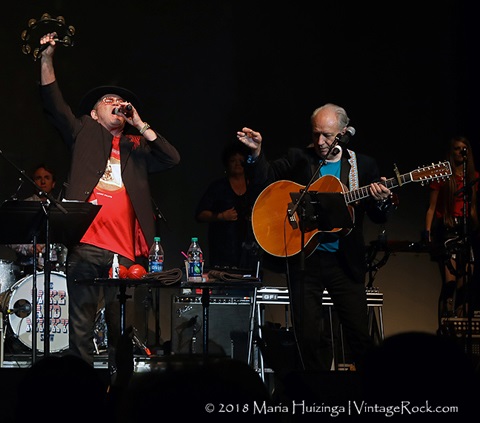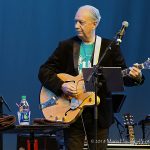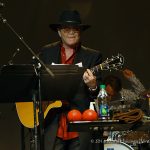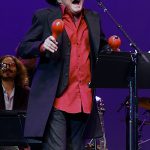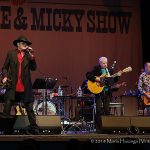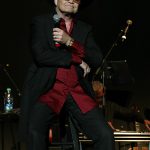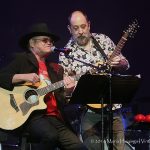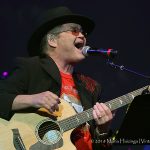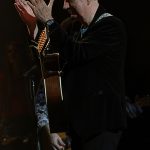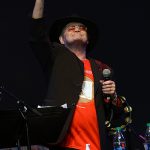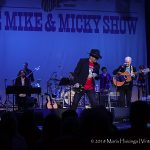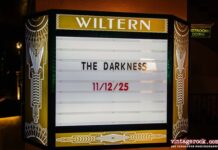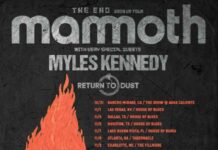Review by Shawn Perry
Photos by Maria Huizinga
“It’s The Monkees! They weren’t even a real group…” so said the late comedian Sam Kinison as part of a provocative routine he did back in 1986. Indeed, the made-for-TV band wasn’t a “real group” in the traditional sense. They were four individuals — two actors, two musicians — hired to do a TV show about a band in the mid 1960s. Taking their cues from the Beatles and the Marx Brothers, the Monkees (the band and the TV show) was a hit out of the gate. There was definitely a chemistry. And it just wasn’t the wacky comedics of the show; the music had a true redeeming quality. The songs weren’t mere throw-aways tossed together to support the show; they were picked from the finest songwriters of the day, played by the best musicians of the day, and brought to life by the more than adequate vocal stylings of Micky Dolenz, Mike Nesmith, Davy Jones and Peter Tork — the Monkees themselves.
Sitting a mere 20 feet away, it was hard not to notice how absolutely magical those songs still are when Mike Nesmith and Micky Dolenz, backed by a superb nine-piece band, took the stage at the Grove of Anaheim. By calling it The Monkees Present The Mike & Micky Show, the focus falls squarely on Nesmith and Dolenz, with a shout-out to the reportedly unavailable Peter Tork, and a couple of mentions of the dearly departed Davy Jones. In all actuality, it’s the songs, many sung by Dolenz and Nesmith, that garner the most attention. The fact that both of these guys can still sing reasonably well makes the trip all the more worthwhile.

The backing band, of course, had to measure up to Wrecking Crew standards, and they most certainly do. Lead by guitarist and musical director Wayne Ayers, the ensemble also includes guitarist Christian Nesmith (Mike’s oldest son), backing vocalist Coco Dolenz (Micky’s sister), backing vocalist Circe Link (Christian’s girlfriend). drummer Rich Dart, bassist John Billings, keyboardist Alex Jules, pedal steel guitarist Pete Finney and banjo player, fiddle player and guitarist Paul Kramer. With a band of this size, breadth and capability, the sound was full, every nuance attended to, right down to the banjo part on “Papa Gene Blues.”
With Nesmith on board, much of the music had a country-rock undertow, with not only banjo, but fiddle and Finney’s stinging pedal steel work (not to mention his no-fuss string change while the band played on). In addition to his countrified Monkees songs like “You Told Me,” “You Just May Be The One,” “St. Matthew,” and “Sweet Young Thing,” Nesmith took the spotlight for his own “Some Of Shelly’s Blues,” “Nine Times Blue” and “Different Drum” (a hit for the Stone Poneys featuring Linda Ronstadt in 1967). Next to his easy-going demeanor and tuneful, sometimes too-low-in-volume vocals, Nesmith’s lighthearted quips between songs indicated he’s in a good place with an era that he once vehemently disregarded.

Dolenz, who arguably sang most of the Monkees best known songs, was in strong voice, even as he backed away from the mic when it came to hitting some of the higher notes. He played a bit of acoustic guitar here and there, shook the maracas like a boss, left the drumming to Dart, and worked the front of the stage as the first 10 rows rows filled with VIPs and former Monkees fan club members surged forward without making anyone get out of his or her seat. Dolenz and company treated the audience to snappy renditions of “Last Train To Clarksville,” “Mary, Mary,” “For Pete’s Sake,” “(I’m Not Your) Steppin’ Stone,” “Pleasant Valley Sunday,” and the encore of “I’m Believer.” Reminding everyone that he wrote a Monkees song, Dolenz directed a slimmed-down lineup of four players for “Randy Scouse Git,” featuring a sweet little vocal and mandolin exchange between the singer and Christian Nesmith.
The most recent Monkees album, Good Times, just before rolling into one of its songs, “Birth Of An Accidental Hipster,” which bears all the earmarks of a classic Monkees song with a bit of Pink Floyd elegance on the turnarounds. They also tackled another one from the album called “Me & Magdelena.” Here, Dolenz and Nesmith effortlessly carried the verses down to the wire of intermission.

Another album that received attention was the Head album, the soundtrack for the Monkees hapless, artsy movie of the same name. Hearing “The Porpoise Song” performed live fulfilled everyone’s expectations, while “Circle Sky” and “As We Go Along,” reaffirmed that Monkees songs could even transcend a time in the band’s history when the shine was starting to wear off.
Yes, the songs that Davy Jones sang were left out except “Daydream Believer,” which has become a tribute in recent years to the only British member of the Monkees, the one who usually got the girls. Nesmith’s “Listen To The Band,” which opened the two-song encore, is more of a tribute to the Monkees themselves. There’s even a video from the late 60s on YouTube that features just the four — Tork on keyboards, Dolenz on drums, Jones on tambourine and Nesmith on vocals and guitar — playing through the song before the whole thing goes off the rails. The band you need to listen to is the Monkees!
At the end of the day, no matter how good the songs and the backing band are, the Monkees are the ones who thrilled a generation of teeny boppers and pop song aficionados in the mid 60s, and provided stiff competition to the Beatles, the Stones and other “real groups” of the day. The Mike & Micky Show is a sweet and mindful look at an indisputable legacy that’s as “real” as you can get.



